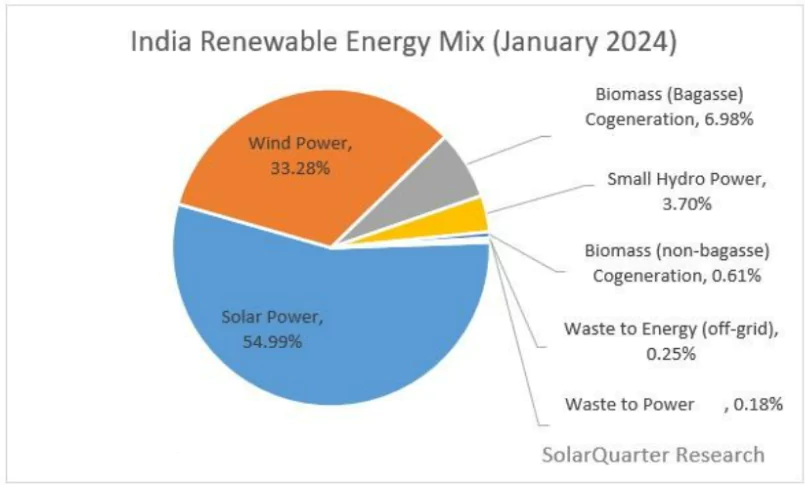India has set an ambitious target of installing 500 GW of non-fossil fuel capacity by 2030, with a strong focus on renewable energy (RE) sources like solar and wind.
What is Renewable Energy?
- Renewable energy is energy derived from natural, constantly replenished sources like sunlight, wind, water (hydropower), and biomass.
- Unlike fossil fuels, it is sustainable, helps reduce greenhouse gas emissions, and promotes a cleaner environment.
India’s Renewable Energy Goals
- 2030 Goal: Achieve 500 GW of non-fossil fuel-based energy capacity.
- Short-Term Milestone: Generate 50% of total energy capacity from renewable sources by 2030.
- Current Progress: Reached 217.62 GW of non-fossil fuel-based energy capacity as of January 2025.
- Net-Zero Commitment: Attain net-zero carbon emissions by 2070.
- However, a closer analysis reveals that these targets may not be enough to meet the country’s rapidly growing electricity demand while ensuring grid stability and reducing reliance on coal.

Government Initiatives to Promote Renewable Energy in India
- International Solar Alliance (ISA): Strengthens international collaboration to scale up solar energy deployment globally.
- Pradhan Mantri Kisan Urja Suraksha evam Utthaan Mahabhiyan (PM-KUSUM): Promotes solarization of agricultural pumps (standalone & grid-connected) through installation of small solar power plants on barren/fallow land.
- PM Surya Ghar Muft Bijli Yojana: Encourages rooftop solar adoption, particularly in urban households, by providing financial and infrastructural support.
- Green Energy Corridor (GEC): Upgrades transmission infrastructure in renewable-rich states to ensure efficient evacuation and distribution of clean energy.
- Faster Adoption and Manufacturing of Electric Vehicles (FAME): Promotes electric mobility, thereby complementing the shift towards cleaner energy sources.
- National Smart Grid Mission (NSGM): Supports the modernization of power grids to better integrate intermittent renewable sources like solar and wind.
- Renewable Purchase Obligation (RPO) & Renewable Energy Certificates (REC):
- RPO: Mandates power distribution companies (DISCOMs) to procure a certain percentage of electricity from renewable sources.
- REC Mechanism: Allows trade of renewable energy certificates to meet RPO targets.
- Production-Linked Incentive (PLI) Scheme for Solar PV Manufacturing: Boost domestic manufacturing of high-efficiency solar PV modules.
|
Challenges to Renewable Energy in India
- Rising Demand: Electricity demand is surging, especially from air conditioning, electric vehicles, and industrial activity.
- Even If all renewable energy projects are completed on time, RE will fall short by about 12% in meeting incremental annual demand by 2030.
- Intermittency and Variability of Supply: Solar power is dependent on sunlight and varies throughout the day, while Wind power is more seasonal and location-specific.
- Wind energy is highly seasonal, with the majority of generation occurring during monsoon season.
- Grid Integration and Stability: India’s grid infrastructure is not fully optimized to handle the variable nature of renewable energy.
- There were 31 events involving generation loss of above 1000 MW from renewable power plants between January 2022 and May 2023.
- Energy Storage Limitations: Energy storage technologies like batteries and pumped hydro are essential for bridging the gap between supply and demand.
- High upfront and lifecycle costs—especially for advanced batteries—pose economic challenges, particularly in large-scale applications.
- High Capital Costs and Financing Gaps: Investments in infrastructure (like large solar parks and wind farms) require significant capital.
- As per Moody’s Ratings estimates India will need to spend up to $385 billion to meet renewable energy targets by 2030.
Way Forward
- Upgrade Grid Infrastructure: Improve grid systems to handle variability in renewable energy, incorporating real-time balancing, smart grids, and demand response mechanisms.
- The government has launched the Green Energy Corridor scheme to upgrade transmission infrastructure to ensure efficient distribution of clean energy.
- Scale Up Renewable Energy Installations: Double the rate of renewable energy installations.
- In 2024 India’s renewable energy capacity saw 15% growth, and has reached 209.44 GW by December 2024
- Balance Energy Security and Environmental Goals: Minimize fossil fuel dependence while ensuring energy security.
- In 2024 coal accounted for 70% of India’s electricity generation which needs to change for a sustainable environment.
Conclusion
While India’s 2030 targets are a step in the right direction, they fall short in addressing real-time demand, storage limitations, and grid stability. Without urgent reforms, the country risks increased coal dependency, delaying its net-zero goals. The solution lies in scaling up renewables strategically, improving storage, and aligning policies with real-world grid needs.
![]() 24 Apr 2025
24 Apr 2025


